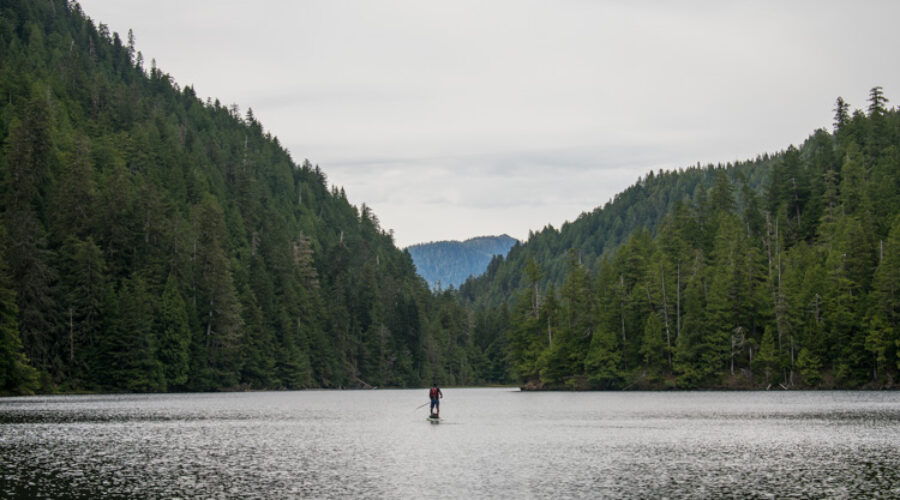Stand Up Paddling the Grease Trail
In the Throne Room of the River, Ocean and Mountain Gods.
Paddle board adventurers and friends Bruce Kirkby and Norm Hann set out to follow an ancient Gitga’at Nation Grease Trail, located in British Columbia’s Great Bear Rainforest.
This connected series of rivers, lakes and portage trails were once used to transport oolichan grease inland, where it would be traded for furs and meat. (Note: Oolichan are small smelt-like fish, so greasy that their dried bodies can be burnt like candles).
Norm — an adopted member of Hartley Bay’s Raven Clan – learned of the abandoned route years earlier.
Paddling the Grease Trail;
In the Throne Room of the River, Ocean and Mountain Gods
Bruce Kirkby
May 2019
DAY ONE
Location: Great Bear Rainforest
Hello, Bruce Kirkby here, Starboard Dream Team member and long-time wilderness paddler, here’s our expedition story of discovering the Grease Trail by paddleboard.
After receiving blessings and advice from Gitga’at elders, we set out with seven days of food and camping gear strapped atop our inflatable paddleboards.
In the days ahead, I’ll share the story of this journey. If you have any questions, please don’t hesitate to ask. I’m keen to spread knowledge about SUP expeditions and showcase the extraordinary capabilities of paddleboards in wilderness settings.
DAY TWO
Location: Quall River
Dropped off by motorboat at the mouth of the Quall River, we paddled and dragged our SUPs upstream,
past ancient village sites, beneath Avitar-like grooves of Sitka Spruce.
Slowly but steadily the creek shrank.
Log jams, and thickets of thorny Devil’s Club soon blocked our way.
Shins and forearms grew scratched and bloody as progress slowed to a crawl.
Two days later, as we neared the headwaters of the Quall River, we searching for any signs of the ancient portage trail, leading towards the Ecstall River drainage.
DAY THREE
Location: Lost in Time
‘You’ll know the trail when you see it,’ a Gitga’at archaeologist told us before departure. ‘Many, many feet have walked there.’
Suddenly the way opened before us. Despite hundreds of years of disuse, the ancient route was unmissable. Hefting our boards and dry bags, we scrambled over wet rocks and logs. Out of respect, we took no photos of the trail.
Many hours later, we reached a maze of creeks and tarns, the dark waters clogged with deadfall.
After 13 crushing hours, and after more than 50 portages, we reached the banks of the Ecstall River. A hasty dinner and sip of scotch followed.
Then we collapsed into the tent, set in the shadow of an enormous driftwood log, more than ten-feet in diameter.
DAY FOUR
Location: Ecstall River
It was pouring rain as launched onto the Ecstall River.
The water underfoot was crystal-clear, swift and playful.
Fingers of mist wove through the ancient temperate forest rising abobe
The Ecstall remains the largest intact-yet-unprotected drainage in the Great Bear Rainforest.
Occasionally class II/III boulder gardens appeared.
Amid this Eden of tangled green and birdsong, came the powerful sense that everything here was exactly as it was supposed to be.
DAY FIVE
Location: Ecstall River
With every passing day and mile, the Ecstall River grew stronger.
Eventually, the ocean neared. The tang of saltwater drifted on the air, and we began to feel the pull and push of tides.
I imagined we had left the wondrous wilderness behind… then we rounded a corner and found ourselves face-to-face with sheer granite monoliths, rising sheer from the river.
The grandeur of the unexpected scene rivalled Yosemite. Awestruck, Norm and I drifted below the cliffs.
For a time, we lay on our boards, speechless, warmed by the sun, munching on energy bars, gazing upwards.
It was as perfect a moment as I have ever known.
DAY SIX
Location: Port Essington
We spent our final night camped beside the abandoned cannery of Port Essington.
During its gold rush heyday, more than 1000 souls lived and worked here. Today, all that remains are rotting pilings and a scattering of broken glass and rusty machine parts
Travelling down the powerful Skeena River, we soon entered the ocean, its waters inky and smooth.
As we neared Prince Rupert, log booms, purse seiners and a container port appeared.
After seven days and 225 kilometres, we completed our Grease Trail journey at Metlakatla village.
Before this story ends, I’d like to extend a sincere thanks to the Gitga’at Nation for welcoming us on their homeland, and allowing us to travel this sacred route.
Thanks also to Norm; trusted expedition partner and a great friend.
And of course, thanks to Starboard and this special SUP community. I hope to see you out on the water soon.
































